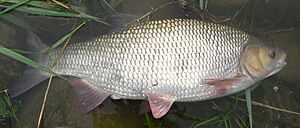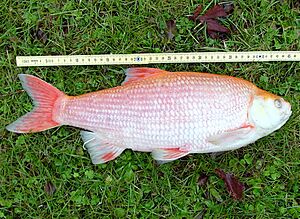Ide (fish) facts for kids
Quick facts for kids Ide (fish) |
|
|---|---|
 |
|
| Conservation status | |
| Scientific classification | |
| Synonyms | |
|
The ide (Leuciscus idus), also called the orfe, is a freshwater fish. It belongs to the Cyprinidae family, which includes carps and minnows. You can find ide in big rivers, ponds, and lakes across Northern Europe and Asia. This fish has also been introduced to other places, like parts of Europe, North America, and New Zealand. It's a popular fish for ponds, especially the "golden orfe" variety. People often keep them in outdoor ponds in areas with mild weather. Sometimes, they escape from these ponds into local waters.
Contents
What's in a Name?
The name "ide" comes from the Swedish word id. This word originally described the fish's bright color. Think of how the German word Aitel means a bright fish, or Old High German Eit means fire.
The other name, "orfe," comes from the German word Orf. This word then connects to the Latin orphus, which means a "sea fish" or "sea perch." This Latin word itself comes from the Greek orphōs.
The scientific name for the group of fish the ide belongs to, Leuciscus, comes from the Greek word leykiskos. This means "white mullet."
Types of Ide
There are two main types, or subspecies, of the ide that scientists recognize:
- L. i. idus (Linnaeus): This is the most common type.
- L. i. oxianus (Kessler, 1877): This type is found in central Asia.
Appearance and Features
The ide is a sturdy fish with a fairly deep body. It looks quite plump. The part of its body just before its caudal fin (tail fin) is thick.
When they are young, ide fish have dark backs and shiny silver sides. As they get older, their sides develop a golden shimmer. No matter their age, their eyes are yellow. Their pectoral fins (fins near the gills) and anal fin (fin on the underside) are reddish.
Size of Ide
Ide fish usually grow to be about 25 to 50 centimeters (10 to 20 inches) long. Their normal weight is between 0.5 and 1.5 kilograms (1 to 3 pounds). It's rare for them to weigh more than 2 kilograms (4.4 pounds). The biggest ide ever caught with a fishing rod in Europe weighed 5.5 kilograms (12 pounds). There have even been reports of ide growing up to 100 centimeters (about 3 feet) long and weighing 8 kilograms (17.6 pounds)!
Where Ide Live
The ide is originally from Europe and western Asia. You can find them in rivers that flow into the North Sea, stretching east through southern Scandinavia and eastern Europe, all the way to the Caspian Sea and the River Lena.
Because they are popular ornamental fish, ide were brought to Great Britain in 1874. Now, they are common in England and Wales. However, they are only found in a few specific places in Scotland. They were also introduced to France and then to the Netherlands as pond fish.
Ide in Other Countries
The ide first came to the United States in 1877. Live fish were brought in to be put into American waters on purpose. They also spread when they escaped from fish farms. Ide have been reported in nine states. However, it's not clear if they have successfully created lasting populations there.
In the 1980s, ide eggs were brought into New Zealand without permission. Fish were then released in several places north of Auckland. It seems that ide did not survive long in most of these places. But they likely still live in the wild in at least one area in New Zealand.
Habitat and Life Cycle
Ide fish live in groups, called schools. They prefer clear, calm parts of large rivers, ponds, and lakes. In winter, they might move to deeper waters. Then, in spring, they move back to shallow fresh water to lay their eggs.
You can also find ide in the Baltic Sea. This sea has less salt than most oceans. In Sweden, young ide spend their first year in rivers. Then, they join older fish and swim downstream into the Baltic Sea for the summer. In autumn, they return to the rivers. They stay near the river mouths and lower parts throughout the winter.
Reproduction
Ide fish are ready to have babies when they are 3 to 5 years old. This is usually when they are about 22 to 43 centimeters (9 to 17 inches) long. In colder waters, they might not start breeding until they are 7 years old.
They lay their eggs in shallow water in the spring. This happens soon after the ice melts in colder regions. Some groups of ide travel up rivers and streams to lay eggs. Other groups lay eggs in shallow parts of lakes and sea inlets. The eggs are usually laid among gravel or on plants growing in the water.
Spawning, or egg-laying, usually lasts for 3 to 4 days. During this time, the fish are very active. Each female lays eggs only once a season. However, she mates with several males. Males gather at the spawning grounds and follow the females ready to lay eggs. A female can lay anywhere from 15,000 to 250,000 eggs in one season! The eggs are about 2 millimeters (0.08 inches) wide and pale yellow.
The eggs hatch in 1 to 2 weeks. The tiny baby fish, called fry, are 8 to 10 millimeters (0.3 to 0.4 inches) long. How long it takes for eggs to hatch depends on the water temperature. At 18.5-22.0 °C (65-72 °F), it takes about 5 days. The best temperature for the eggs to develop is between 12-18 °C (54-64 °F).
What Ide Eat
Smaller ide fish eat insect larvae, adult insects, snails, and other small creatures that live on the bottom of the water. Larger ide can also eat other fish. They often hunt for common roach and common bleak.
Young ide and fry live and feed in many different shoreline areas. As they grow bigger, they leave the shore and move into deeper waters. Smaller ide are social and join mixed groups with other carp-like fish. But larger adult ide form smaller groups of only their own species. These groups seem to follow regular routes.
Ide prefer clear, warmer water. They don't handle water pollution as well as some related fish species. Ide lay their eggs in flowing water. So, things like dams that block rivers can harm these fish.
Ide and People
When used as an ornamental fish, the ide is usually called the orfe. The most common type kept is the golden orfe. These fish are golden or orange with some black spots near their head and neck. There is also a much rarer blue type called the blue orfe.
Since they grow quite large, ide are not usually kept in indoor fish tanks. It's better to keep them in a group in an outdoor pond. They need water with more oxygen than koi or goldfish. However, they can still live with these other pond fish. Golden orfe were very popular pond fish until koi became more widely available in the 1960s.
In their native areas, people enjoy fishing for ide. In eastern Europe, ide are considered good to eat. They are caught in nets and sold in markets along the Danube River. However, in more northern regions, people don't usually eat them. In the United Kingdom, people also fish for them, but they are mostly found in special fishing spots or places where they were introduced.



